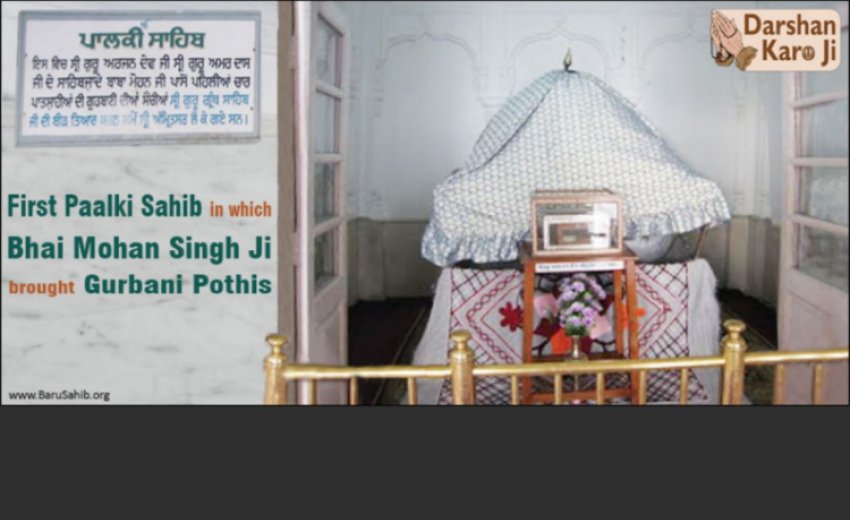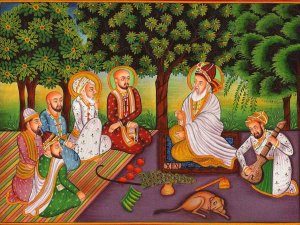Baba Mohan was the son of Guru Amar Daas and in Punjabi Baba is used to address or write the name of elders. Pothi means book, but it is mostly used for a sacred book and Valian means belonging to. It is said that Guru Arjan Dev procured these Pothies from Baba Mohan and utilized them in the compilation of The Adi Sri Granth Sahib as they contained hymns of the first three Gurus and some Bhagats. These are also known as Goindval Valian Pothian as they were transcribed at Goindval where the third Guru stayed. These are also called Sahansar Raam Valian Pothian as Sahansar Raam s/o Baba Mohan was the writer of these Pothies.
Volumes of the Pothis
It is said that there were 4 Pothis, but only 2 Pothis are still extant and are in the custody of the descendants of Guru Amar Daas. Nobody knows about the other two. The first one was at village Darapur in Hoshiarpur district (Punjab), now moved to Jallandhar. A photo copy of this is available in the Punjabi University, . The second one is with the family of Bava Bhagat Singh now settled at Pinjaur near Chandigarh. The size of both the Pothis is 13 by 9.5 inches. Both the manuscripts contain 300+240 folios or 1,048 pages. At some places some pages are left blank for the hymns that may be available afterwards. Gurmukhi script of initial stage has been used in these Pothis. This note--Guru Angad Gurmukhi Akhar bandi Babe age sabad bhet kita (Guru Angad coined Gurmukhi letters and presented to the Baba ) is recorded on folio 216 of the second volume. Shape of some letters closely resembles with those of their counterparts in Sarda and Takari scripts. Folios 167 and 227of the 1st Pothi are written in Lahndi script by a different hand. Use of the Pothis for scholarly study is not allowed by those who possess them. The writers of the present days write on the basis of notes taken by persons like Giani Gian Singh and Bava Prem Singh Hoti who had the privilege of studying those and taking notes.
Contents of the Pothis
The first Pothi contains hymns of Guru Nanak Dev in the following 8 musical measures-- Suhi, Prabhati, Dhanasri, Basant, Tilang, Gujari, Bhairo and Aasa. Only a few hymns of the third Master is in Dhanasri and Parbhati musical measures. Some Compositions of Bhagats like Kabir, Namdev, Trilochan, Ravi Daas, Jai Dev, Rama Nand and Sain are also there. There are Ashatpadis, Saloks and Chhands besides Sababds. The second Pothi contains hymns in the following Ragas: Maroo, Raamkali, Sorath, Sarang and Malar. Only 14 different ragas have been used in these manuscripts. Most of the hymns are from Guru Nanak Dev, Guru Amar Daas and the Bhagats- Kabir, Namdev, Ravi Daas and Bhikan. This Pothi also contains these compositions: Sidh Goshat, Anand and Ikonkar.
The Pothis Contain Many Mistakes and Omissions
These Pothis do not go along with our holy scripture, SGGS and contain many mistakes and omissions. Some of them are listed below:
- Authorship of 10 hymns has been changed. For example a hymn of Guru Nanak Dev in Soohi measure starting as :ijn kau BWfY Bwau iqnw svwrsI ]( SGGS:729) has been recorded as that of Guru Angad
- These Pothis do not contain all the writings of the first and the third Masters although it is claimed that these have been scribed under the third Master. Japuji, the most important composition of Guru Nanak and Vars composed by the first and the third Masters do not find place in them. Only selected and limited material has been included.
- Though the raga pattern has been adopted, yet the sequence of ragas is different from that of the Adi granth.
- In many hymns, arrangement of the parts (pidAW) of the hymn is not same as in the Aadi Granth.
- Some hymns have been written twice.
- Some hymns which are there in these Pothis find no place in The Adi Granth.
- A different arrangement of the hymns within a raga has been adopted.
- No index has been appended.
- In the case of many hymns authorship, Mohalla, has been omitted.
- At many places reference to Ghar (Gr) has been omitted.
- Mul Mantra scribed in these volumes contains many inaccuracies and discrepancies.
- In the first Pothi, it has been recorded as:
Existence of Spurious Hymns (Kachi Bani)
Guru Amar Daas hd cautioned us against spurious hymns by mentioning it in Anand Sahib: bwxI q kcI siqgurU bwJhu hor kcI bwxI ] (SGGS:920) 'Without the True Guru every other word is false. All other sermons are false.' Writers of the article 'A Peep into the Goindval Pothis' have pointed out 16 such hymns that find place in these volumes. These hymns have been composed by dubious authors such as ijgru, gulwm, sdw syvk[ These authors use the pen name of 'Nanak' for themselves. For example a spurious hymn in Raag Tilang on page184 of the first Pothi has been attributed to Guru Nanak Dev. This hymn starts with these words: Alhu eyk krIm kudriq ---Mostly in these hymns the word Nanak is written as Nanik (nwnik).
Author and Time of Writing of these Pothis
Dr. Gulshan Kaur Jaggi and some other scholars believe that these volumes were written by Sahansar Ram grandson of Guru Amar Daas under his supervision between the years 1570 and 1572, but the first folio of the first Pothi shows 1595A.D as the year of its compilation. Dr. Dhillon does not want to ignore this while Dr. Gurinder Singh Mann does not agree. Dr. Gursharn Kar Jaggi quotes on page 30 of her book (bwbw mohn vwlIAW poQIAW) that there are signatures of Guru Ram Das (gulwm msqwn jyT cMd) on page 94 of the second volume. Guru Ram Das was called Jeth Chand before he became Guru in 1574. But Dr. Balwant Singh Dhillon des not agree with her. He writes that there are only these letters (g lw m s q q f j t) which have been construed as autograph of the fourth Master who was never called Gulam or Mast. In fact, Baba Mohan was known as Mast. Moreover, he rightly points out that the letter 'th' (T) and not 't' (t) is used for writing Jeth Chand. He writes that these volumes are post- Guru Ram Daas product as hymns from the 4th and the 5th Masters scribed by the original writer are found in these volumes. Dr. Gurinder Singh writes that these hymns were scribed later on. No doubt, additions are also found in the compositions of Sidh Goshat and Anand Sahib. Dr. Dhillon is of the view that these volumes belong to post- Guru Ram Das period and he has pointed to a couplet by Harji, a grandson of Prithi Chand, on folio 283 of the first volume scribed by the original writer. I feel rivals of the Gurus, the Minas, were out to confuse the originality and authenticity of Gurbani. Dr. B.S. Dhillon refers to a note on the first folio of the first Pothi that threatens a curse of hell for those who do not follow the family of the scribe.
A Misunderstanding
There is a hymn by Guru Arjan Dev in praise of Mohan. Some of our preachers have constructed a story on the basis of this hymn and say that Guru Arjan Dev went to Baba Mohan, s/o Guru Amar Das, the 3rd Master, praised him and begged for the loan of the (Pothis) notebooks containing the hymns of his predecessors for editing the Adi Granth. First line of this hymn goes like this:
mohn qyry aUcy mMdr mhl Apwrw ] mohn qyry sohin duAwr jIau sMq Drm swlw ] ( SGGS:248)
'O sweet-heart, lofty are Thy buildings and unsurpassed Thy mansions. My Enticer! Beauteous are Thine gates. They are the places for the worship for the saints.'
Late Prof. Sahib Singh has logically and convincingly refuted this theory. He says the word Mohan has been used in SGGS several times for God, and here too it stands for God and not for Mohan s/o Guru Amar Das as he had no lofty building and mansions where saints assembled to pray. Prof. Sahib Singh writes on page 712 of the 6th volume of his book Guru Granth Darpan (2nd edition) and page 812 0f the 3rd volume that Guru Nanak Dev noted his compositions in a note book that he gave to Guru Angad Dev who along with his own handed over to Guru Amar Daas. In this way the compositions of the first 4 Gurus reached Guru Arjan Dev. I also agree with Prof. Sahib Singh, but Dr. Gursharn Kaur Jaggi, author of Baba Mohan Valian Pothian' does not agree. Dr. B.S. Dhillon also agrees with Prof. Sahib Singh and writes that the story of Guru Arjan Dev going all the way to Goindwal is a later concoction.
Conclusion
These Pothis are an important part of our old religious literature. They depict the first stage of Gurmukhi letters. The second volume contains a note which proves that Gurmukhi letters were coined by Guru Angad Dev. Authorship and time of writing of these volumes are disputed. They cannot be treated as a base for the compilation of the Adi Granth as they are incomplete and full of inaccuracies. They contain only 14 musical measures while the Adi Granth has Gurbani in 30 Ragas. It is not right to say that these were prepared under the guidance of the third Master as they contain omissions and mistakes. It seems that these were written earlier, but additions continued to be made later. Spurious hymns in these volumes prove that some interested persons messed up with them. More research is required to be made on these pothis, but it is possible if the custodians of these Pothis entrust them to some university for further research.
Bibliography
- A Peep into the Goinval Pothis' byDr. B.S. Dhillon and Prof.Aarjit Singh in Abstracts of Sikh Studies , October, 1995
- Encyclopedia of Sikhism Vol.one, Punjabi University, Patiala
- Baba Mohan Valian Pothian 91987) by Dr. Gursharn Kaur Juggi
- Gurbani Te Ithas Bare(1960) by Pro. Sahib Singh
- Sri Guru Granth Sahib Darpan Volums 3rd and 2nd by Pro. Sahib Singh
- Gurbani te Ithas Bare. By Prof. Sahib Singh
Header Image Source





